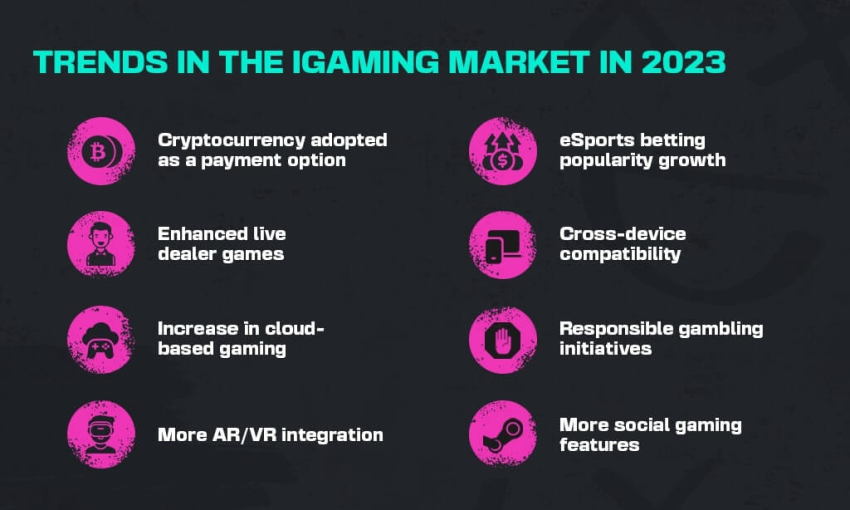The iGaming industry is experiencing explosive growth, with projections suggesting that the global market will exceed **$213 billion** by 2025. This unprecedented development is a result of significant iGaming technology advancements and evolving market dynamics, making it essential for stakeholders to stay informed on current iGaming market trends. Online gaming statistics reveal a dramatic rise in participation and revenue, fueled by the increasing legalization of online gambling and changing consumer habits. As operators adapt to new regulations in iGaming, the opportunities for innovation and user engagement expand, particularly in burgeoning markets. Understanding these aspects of the growing iGaming industry is critical for businesses aiming to capitalize on this lucrative space.
The online gaming sector, encompassing various forms of digital gambling, is witnessing remarkable escalation, fueled by technological breakthroughs and regulatory shifts. It is crucial for stakeholders to grasp the nuances of this fast-evolving interactive entertainment landscape, marked by substantial increases in player engagement and market investment. Reports indicate that the realm of virtual casinos and betting platforms is not only gaining popularity but also instigating significant changes in demographic participation and market strategies. As more consumers gravitate toward online gambling, guided by the latest trends and stats, operators must navigate an increasingly competitive environment while adhering to emerging legislation. Thus, comprehending these elements is vital for those invested in the online gaming sphere.
Spotlight on iGaming Industry Growth: Understanding Market Dynamics
The iGaming industry growth is not merely a statistic; it represents a significant shift in consumer engagement with entertainment and leisure. With projections indicating that the market will exponentially exceed **$213 billion** by 2025, the question arises: what factors are driving this impressive growth? The evolution of consumer behavior plays a pivotal role, as today’s players increasingly prefer the convenience and accessibility of online gaming platforms. Coupled with advancements in technology, such as enhanced mobile gaming applications and secure online payment methods, the growing iGaming industry is quickly becoming the preferred option for entertainment over traditional venues.
Moreover, the integration of innovative technologies like blockchain and virtual reality is revolutionizing how players interact with games. Security and transparency are major concerns for users, and blockchain technology addresses these issues, thereby enhancing trust in online gaming environments. As players demand more engaging and interactive experiences, the industry must continuously adapt to meet their needs. Failure to do so could result in a loss of market share to competitors who are willing to invest in new technologies and user-centric designs.
The Role of Regulations in Shaping the Growing iGaming Industry
Regulations in the iGaming sector play an essential role in its growth trajectory, as they delineate the legal framework within which operators can function. As states like Texas engage in discussions about legalizing sports betting, the potential for expansion into previously untapped markets comes into focus. Such regulatory changes are instrumental in creating a safe and well-structured environment for both operators and players. Furthermore, as more regions adapt their legislation to permit online gambling, the industry can anticipate a surge in participation, ultimately contributing to the projected market growth.
However, this evolving regulatory landscape presents its own set of challenges. Operators must navigate complex compliance requirements while attempting to innovate and offer competitive products. For instance, understanding which cryptographic currencies can be legally accepted in various jurisdictions can be a daunting task. Therefore, staying informed about regulatory trends is crucial for companies seeking to thrive in the growing iGaming industry. By doing so, they can not only ensure compliance but also position themselves advantageously to capitalize on new opportunities as the industry continues to expand.
Frequently Asked Questions
What are the key market trends driving iGaming industry growth?
The iGaming industry growth is primarily fueled by technological advancements, regulatory changes, and shifting consumer preferences. Notable market trends include the increasing integration of blockchain for enhanced security, the rise of mobile gaming platforms, and the legalization of sports betting in various regions. With projections indicating that the global iGaming market could exceed $213 billion by 2025, staying ahead of these trends is crucial for operators.
How are regulations impacting the growth of the iGaming industry?
Regulations play a significant role in iGaming industry growth by shaping market access and consumer protection. As more jurisdictions legalize online gambling and sports betting, the opportunities for expansion increase. For instance, discussions surrounding sports betting legalization in states like Texas could unlock substantial new markets. Moreover, the acceptance of cryptocurrencies enhances payment security, which in turn attracts more players and contributes to the overall growth of the iGaming sector.
| Key Points | Details | |
|---|---|---|
| Market Growth | Projected to exceed $213 billion by 2025 due to digitization and changing consumer preferences. | |
| Emerging Technologies | Blockchain, VR, and enhanced mobile gaming are key technologies driving growth. | |
| Market Regulation | Ongoing focus on regulation, including potential for sports betting legalization in Texas and cryptocurrency acceptance. | |
| Demographics | Younger generations, like millennials and Gen Z, are increasingly participating in online gaming, necessitating tailored experiences. | |
| Regional Growth | Markets in South America, particularly Brazil and Argentina, show promising growth potential due to better internet access and infrastructure. | |
| Challenges | Data availability and regulatory hurdles present significant challenges to operators navigating international compliance. | |
Summary
The iGaming industry growth is undeniable, as evidenced by its projected market expansion. To navigate this evolving landscape effectively, stakeholders must consider the rapid developments highlighted. Embracing technological advancements and understanding the shifting regulatory environment are paramount for seizing new opportunities. Moreover, recognizing demographic trends and regional market insights plays a crucial role in crafting tailored strategies. As the iGaming sector continues to mature, addressing the challenges ahead will be essential to sustain this growth trajectory, ultimately redefining how entertainment is delivered and experienced.
